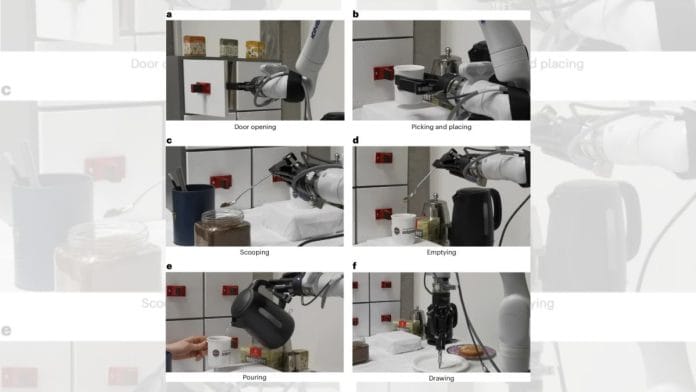New Delhi: In good news for coffee lovers, artificial intelligence is set to make their lives easier. Scientists at the University of Edinburgh have developed an AI-powered coffee-making robot that is fully equipped to handle and work in the chaos of a kitchen. The study was published in Nature Machine Intelligence journal on 19 March.
A robot that makes something as simple as coffee might not be a great invention in this day and age, but this new robot is something else. It can hear you verbally ask it to make a coffee, analyse its surroundings, navigate a kitchen shelf to find a coffee mug, and then mix coffee grounds with water to make a ‘cup of joe’.
In the middle, if you accidentally bump into it, or move the coffee mug, instead of malfunctioning this AI-powered machine can readjust to its environment.
What this neat little invention does, beyond making coffee easier, is merge artificial intelligence with robotics, paving the way for other, bigger inventions someday, such as in the field of precision surgery or navigation. Read More.
Glucose levels detection without needles
The process of detecting glucose levels in the blood is often painful and cumbersome, needing multiple pinpricks, even in the most compact devices. But now, a new paper in Science Advances by scientists at the Indian Institute of Science (IISc), Bengaluru, shows a new method of monitoring glucose in the body by using photoacoustic sensing.
As the name suggests, this is a non-invasive process that uses light and sound waves to detect the presence of molecules inside human tissues.
The particular process proposed by the IIsc scientists includes flashing a beam of light onto human skin and then assessing glucose levels based on how much light the glucose molecules absorb. The paper found that the glucose levels detected through this approach had near clinical accuracy.
If developed and adopted widely, this could be a huge relief for diabetes patients especially, as they have to check their glucose multiple times throughout the day. However, the technology has yet to be taken to a commercial level. Read more.
New world found under broken Antarctic iceberg
Scientists from the Schmidt Ocean Institute, an international NGO, have found an entire undiscovered marine ecosystem 1,300 metres deep in the ocean in Antarctica. This discovery was made possible after a huge iceberg, the size of Chicago city, broke off from an Antarctic ice shelf, revealing the ocean floor beneath it.
In the first-ever comprehensive study of the sea floor underneath the iceberg, the scientists were stunned to find a “beautiful, thriving ecosystem”, in the words of one of the scientists.
This is possibly the first time humans have ever accessed this marine underworld, and despite no access to sunlight, corals, sponges, icefish, sea spiders, and octopi were found there.
While there needs to be more in-depth work on each of these species that have been found, the scientists are confident that they have discovered many new species residing 200-300 metres deep in the ocean, hidden from the surface. Read more.
Supernova events millions of yrs ago led to extinctions on Earth
The death of a star—a celestial, not the Hollywood, kind—can lead to marine life going extinct on Earth, scientists in the UK have found. The study by Keele University, published in Monthly Notices of the Royal Astronomical Society on 20 March, explores how large supernova events that occurred when a star died led to two mass extinction events on Earth millions of years ago.
The scientists worked backwards. They knew that two of the major mass extinction events on Earth—the late Devonian Extinction (372 million years ago) and the Ordovician Extinction (445 million years ago) wiped out at least 60 percent of marine species. They also knew that, while the official causes of these events were unknown, they likely had something to do with the ozone layer in the Earth’s atmosphere.
When large supernova events happen close to Earth—and by close, we mean around 65 light-years away—they can have devastating effects on the planet. The impact of the star’s death leads to a huge explosion, which could strip off the earth’s ozone layer, cause acid rain, and expose living beings to the sun’s ultraviolet rays.
By tracing the supernovae events that happened near the Earth, the authors of the study were able to narrow it down and find corresponding supernovae that happened at the same time as the mass extinction events. Read more.
(Edited by Sanya Mathur)
Also Read: AI can’t schedule appointments, or read the time. Researchers from Scotland explain why






